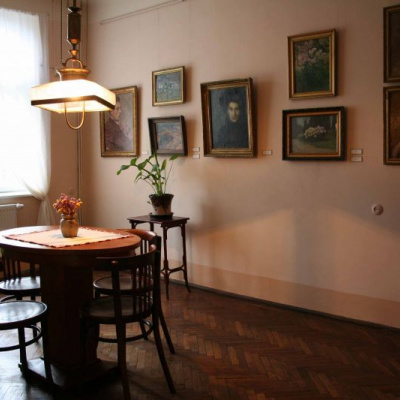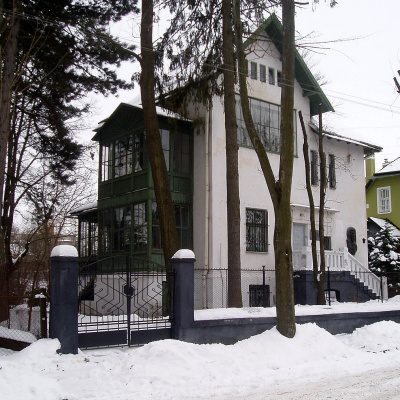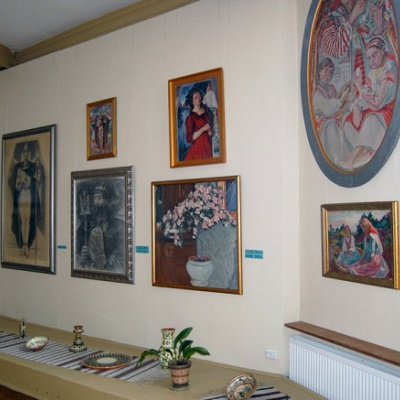Ivan Trush Art and Memorial Museum, Lviv
If you find yourself in Lviv, be sure to get acquainted with the paintings of the famous painter Ivan Trush and visit the two-story villa where the artist once lived. The building, built in the Hutsul Secession style, now serves as the Ivan Trush Art and Memorial Museum, with a permanent exhibition in its halls. The building is small in scale, built in the western part of the city on a separate plot with a garden, in the area of villa buildings. An example of the architecture of a private villa made to the owner's order. Ivan Trush purchased a land plot for the construction of his own house with a total area of 1940 square meters on July 5, 1910, with the mediation of the Sokal and Lilien bank at a price of 2160 crowns. He was obliged to pay the seller the sum in two installments: on September 1, 1910, and January 1, 1911.
Ivan Trush's villa-workshop is one of the first houses on the present-day Trush Street (formerly Obvodna or Obvodova Street). It is located on a large plot, part of which is occupied by a garden. The house is a two-story building with attics and an attic, made of brick and plastered, and is close to a square in plan. It was designed in the late Secession style. The design of the wooden veranda attached to the east uses stylized folk art motifs. The central projection, accentuated on the main façade, is higher than the sides of the villa's building. A three-pitched roof with wooden brackets is built over it. A gable-roofed risalit protrudes from the rear façade. A wooden gallery arranged at the parterre level leads to a two-tiered veranda. The layout of the house is of the hall-enfilade type.
Villa Trusha was built simultaneously as a dwelling and a creative studio. The author of its project was the architect Oleksandr Lushpynskyi. After the death of Ivan Trush, who passed away in 1941, his children took care of the house.
During the Second World War, a bomb fell on the villa during one of the German bombings, damaging the western wing. The house was restored by the artist's daughter Ariadna in the 1950s. This reconstruction changed its appearance somewhat. In particular, a two-story veranda was added to replace the one-story one. Since 1951, under the leadership of Ariadna Trush, the house has hosted a memorial exhibition dedicated to the work of Ivan Trush. Minor repairs were carried out almost constantly.
The Ivan Trush Art and Memorial Museum was opened on March 31, 1986. In 1989, the artist's son Roman Trush, in accordance with the wishes of his late sister, transferred the family estate to the National Museum in Lviv. The exhibition reveals little-known pages in the life and work of Ivan Trush. It features portraits of prominent Ukrainian figures, paintings with views of Lviv and Kyiv, landscapes of the Crimea and the Carpathians, Italian and Egyptian landscapes, as well as family photos and memorabilia. Here you will find portraits of many of the artist's contemporaries with whom he was friends. For example, Ivan Franko, Mykhailo Hrushevsky, and Mykhailo Drahomanov will look at you from the paintings.
The house is marked with the security number 303-M (Lv) as a monument of architecture and urban planning of local importance, included in the register according to the decision of the session of the Lviv Regional Executive Committee No. 381 of July 5, 1985. The object is on the balance sheet of the Andrey Sheptytsky National Museum. In 1992, the garden was landscaped, the facades were restored, and the fence was restored.
But most of all, the exposition features landscapes. The artist loved to travel, so he depicted the Crimea, Egypt, Italy, and Palestine. The main emphasis is on the native landscapes of the Carpathians, on Galician sunsets and Hutsul traditions. It is not for nothing that Ivan Trush, who initiated the revival of Galician-Ukrainian painting, was called a poet of color and sun.
Ivan Trush (1869-1941 ) was a prominent Ukrainian artist, organizer of artistic life in Galicia, art critic, popularizer of Ukrainian culture, editor and publisher of Ukrainian magazines, and active public figure of the early twentieth century. The artist is known as the creator of unsurpassed lyrical and epic landscape paintings, a master of psychological portraiture, and the author of moody genre compositions. His artistic heritage creates an unsurpassed page in the history of Ukrainian and world artistic culture. The I. Trush Art and Memorial Museum is located in the villa where the artist lived and worked. The exposition reveals little-known pages in the life and work of Ivan Trush.
Special attention is paid to educational work with young people. Educational programs based on museum exhibitions are becoming extremely popular, demonstrating new forms of work with the viewer alongside traditional ones.
Within the framework of the cultural and educational projects National Museum and Youth, School and Museum: Working Together, Vacations in the NML: New Life of Old Traditions, and Creative Workshop, integrated lessons and art classes are actively held in the exhibition halls of the Ivan Trush Museum. The combination of lessons in fine arts, history, Ukrainian language and literature, local history, folklore, music, ethnography, and artistic culture in the form of integrated lessons and their conduct outside the usual environment of classrooms and auditoriums - in the museum, among artworks - contributes to a special creative atmosphere of such lessons. Museum lessons involve slide shows, creative tasks, and participation in workshops. To consolidate the new material learned in the classroom and to assess the knowledge gained, an interactive quiz game is used, where students try to answer the questions as quickly and correctly as possible in a playful, relaxed atmosphere.
The modern museum exposition is located on two floors of the estate. The first floor used to be the living quarters: an entrance hall, a kitchen, and two rooms where the artist and his family lived. Although nothing of the original interior of the kitchen has been preserved, the atmosphere of the last century reigns here. Now the first small room exhibits Trush's early works, namely portraits and sketches from the largest series "Landscapes of Galicia", which was created over five decades. In addition to the rich pictorial material, the museum space is organized in modern forms, such as a multimedia panel with extremely interesting information about the life and work of Ivan Trush.
Entrance fees: UAH 15.00 for adults, UAH 10.00 for students, UAH 8.00 for pupils and pensioners.
Prices for guided tours (for groups of up to 20 people): for adults - 50.00 UAH, for students - 40.00 UAH, for pupils and pensioners - 30.00 UAH (with a certificate), family tour (up to 8 people) - 40.00 UAH.
The museum is located near the final stop of tram #2, 300-350 meters from the Tourist Hotel.






